Chlorine is added to our drinking water for an important reason: it kills harmful microorganisms, like bacteria and viruses. But once water reaches our homes, it no longer needs to be chlorinated.
We’ve been working in the water treatment industry for over a decade, and in that time, we’ve tested dozens of methods of removing chlorine from drinking water. In this guide, we’ve shared the most effective methods, based on our own experience and scientific studies we found in our research.
📌 Key Takeaways
The best ways to dechlorinate water at home include water filtration, boiling, UV treatment, vitamin C neutralization, and letting the water sit out.
| Method | Effectiveness | How it Works | Pros | Cons |
|---|---|---|---|---|
| Boiling Water | 90-99.99% | Increases temperature and pressure, forcing chlorine to evaporate | Cheap, accessible, effective | Takes time, may alter taste |
| Letting Water Sit | 60-99.99% | Chlorine gradually evaporates into the air over time | Easy, no equipment needed | Takes 24 hours, not ideal for large volumes |
| Activated Carbon Filter | 85-99.99% | Carbon attracts and traps chlorine molecules as water passes through | Convenient, removes other contaminants | Costs money, needs filter replacements |
| Reverse Osmosis Filter | 90-99.99% | Semi-permeable membrane rejects chlorine and other contaminants | Highly effective, removes most impurities | Expensive, maintenance required |
| UV Light | 90-99.99% | Breaks down chlorine molecules with high-energy photons | Targets chlorine and microorganisms | Costs money, needs installation |
| Vitamin C | 90-99.99% | Ascorbic acid acts as a reducing agent, neutralizing chlorine molecules | Simple, safe, doesn’t affect pH | Effectiveness varies, may alter taste |
| KDF-55 Filter | 95-99.9% | Copper-zinc mixture generates electrical charge, transforming chlorine into less harmful forms | Reduces contaminants, inhibits bacteria | Less effective than some methods, needs filter replacements |
| Water Distillation | 95-99.9% | Heats water until it evaporates, leaving chlorine behind | Thorough purification, removes many contaminants | Slow process, energy intensive, not recommended by CDC/EPA |

Table of Contents
♨️ Boil Your Water
Chlorine reduction rate: 90-99.99%
Boiling water is one of the cheapest ways to dechlorinate water with equipment you already own. Let the water reach a rolling boil for 15-20 minutes.
How it Works
Boiling water causes chlorine to evaporate due to the increase in temperature and the transition from a liquid to a gaseous state.
When water is heated to its boiling point (100 degrees Celsius or 212 degrees Fahrenheit) at standard atmospheric pressure, the energy input causes the intermolecular bonds between water molecules to break. As the water transitions into steam, any volatile substances, including chlorine, are carried with it.
Chlorine’s relatively low boiling point of around -34 degrees Celsius ( or -29 degrees Fahrenheit) means that it should readily evaporate during the boiling process.
Wait for your water to cool before storing it in a clean, covered container or using it for drinking.
The Evidence
- A 2018 study on the efficacy of various methods of removing chlorine from potable tap water noted that chlorine levels in the water post-boiling were detected below the WHO’s threshold for tasting and smelling the chemical in drinking water. The study concluded that the boiling method is the “most effective” compared to off-gassing and filtration treatment methods.
Best For
Folks who want to remove chlorine from tap water at home with a cheap, accessible method and don’t mind a process that doesn’t deliver instant results.
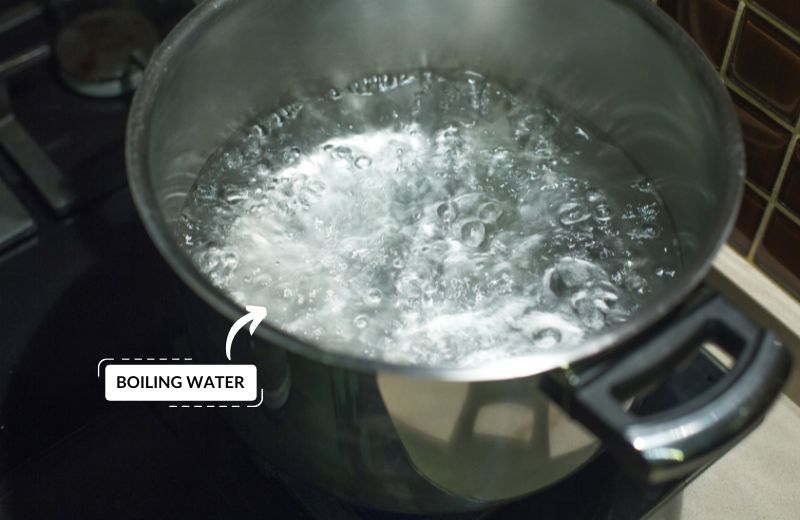
🚰 Let Your Water Sit Overnight
Chlorine reduction rate: 60-99.99%
Another easy but time-consuming way to dechlorinate water is to leave a batch of chlorinated water sitting out for 24 hours. Within this period, most of the chlorine will evaporate naturally.
How it Works
Because chlorine is volatile and weighs less than air at room temperature, it can escape into air from water, gradually dissipating over time.
There are a few factors that affect the speed at which chlorine dissipates from water naturally, including:
- The surface area of the pot or container – Increasing the surface area enhances chlorine evaporation by increasing the opportunity for dissipation across the water’s surface)
- Temperature – Higher temperatures accelerate chlorine evaporation by facilitating the movement of water molecules.
- Aeration – Stirring the water introduces air, promoting the release of chlorine.
- Time – The longer you leave the water to sit, the more chlorine molecules will escape overall.
It’ll take longer for all the chlorine to evaporate in large volumes of water, so ideally, only fill a container with the precise amount of water that you need.
The Evidence
- A 2014 study evaluated the decay of free chlorine in drinking water stored in ambient room temperature and in a refrigerator. It concluded that in water samples containing 0.2-0.8mg/l of free chlorine, the free chlorine decreased by 62% (in the sample stored at room temperature) and 51% (in the sample stored in the fridge) after 24 hours. The study noted that free chlorine diminished sooner in the ambient-stored water due to “exposure to higher temperature and light”.
Best For
Anyone who wants to remove chlorine from their tap water with as minimal effort and equipment as possible, and who is happy to store their water ideally for a full day.
🔮 Use an Activated Carbon Water Filter
Chlorine reduction rate: 85-99.99%
If convenience is what you’re after, look for a drinking water filter that removes chlorine. Most water filters used in pitchers, faucet filters, whole-house filter systems, shower filters, refrigerator filters, and under-sink filters are made from, or contain, activated carbon.
Activated carbon can remove chlorine, its associated tastes and odors, and a select few other harmful contaminants from tap water. The best activated carbon filters can remove up to 99.99% of chlorine consistently until their media reaches full capacity and needs to be replaced.
How it Works
AC filters have a large surface area that absorbs organic compounds and chemicals affecting taste and smell, including chlorine.
These filters remove chlorine using a process called adsorption. As water passes through activated carbon filter media, the chlorine molecules are attracted to the activated carbon, and adhere to its surface. This effectively traps and immobilizes the chlorine, removing it from the water.
Activated carbon can also catalytically reduce chlorine by prompting chemical reactions, which convert chlorine into less harmful substances.
If you want the reassurance that your chosen AC filter definitely removes chlorine, go for a filter that has been tested and certified to NSF Standard 42, for chlorine removal.
The Evidence
- An evaluation of studies into activated carbon for drinking water treatment commented that AC filter media serves as a “very effective reducing agent” for residual chlorine in an aqueous solution. It also noted that GAC offered the most promising removal of total organic carbon, and byproducts associated with chlorine disinfection, including halogenated organic compounds.
- Activated carbon is also a WQA-approved method of removing chlorine from water. In a 2016 GAC fact sheet, the WQA noted that a 10-inch granular activated carbon with a flow of 0.5 GPM (gallons per minute) can remove 95% of incoming chlorine for up to 2500 gallons.
Best For
People looking for a practical, affordable method of dechlorinating tap water that delivers fast (in some cases, instant) access to low-chlorine or chlorine-free drinking water.

⚗️ Use a Reverse Osmosis Filter
Chlorine reduction rate: 90-99.99%
Reverse osmosis filters are multi-stage filtration systems that remove chlorine and a whole host of other contaminants from water.
RO systems can remove both chlorine and chloramine, so they’re a good option for chloramine-treated water. Plus, RO filters can also remove dangerous disinfection byproducts that are commonly found in drinking water alongside chlorine.
Reverse osmosis water filters are most commonly used as under-sink applications, but whole-home and countertop RO units are also available.
How it Works
Reverse osmosis filters often include a sediment filter, a simple carbon filter, and a semi-permeable membrane.
As we know, carbon filters are a really effective chlorine removal solution when used alone. But in a reverse osmosis system, if any chlorine is able to pass through the carbon filter stage, it should be removed by the semi-permeable membrane.
An RO membrane has tiny pores (usually 0.0001 microns in size) and rejects any contaminants larger than this, including chlorine.
RO is such an effective means of water purification that virtually all contaminants are removed using this method, so tap water is purified as well as being chlorine-free.
Again, if you want to be certain that a reverse osmosis filter removes chlorine, look for a filter with an NSF Standard 58 certification, with chlorine listed as a contaminant removed within this certification.
The Evidence
- A 2017 study on the efficacy of household reverse osmosis systems to remove pollutants in tap water, river water, and well water, reported that the RO process had a 100% removal efficiency for free residual chlorine.
- Reverse osmosis systems are also noted in the CDC’s guide to household drinking water treatment technologies as being an effective solution to remove common chemical contaminants.
Best For
Folks with the budget for a costlier water treatment system who want to remove as much chlorine as possible from their water and eliminate the majority of other dissolved solids, resulting in water that’s almost completely pure.
Reverse Osmosis Filters
Reverse osmosis filters are multi-stage filtration systems that remove chlorine and a whole host of other contaminants from water. These filters often include a sediment filter, a simple carbon filter, and a semi-permeable membrane, which removes up to 98% of chlorine in water.
RO systems can remove both chlorine and chloramine, so they’re a good option for chloramine-treated water. Plus, RO filters can also remove dangerous disinfection byproducts that are commonly found in the water supplies of Western countries. RO is such an effective means of water purification that virtually all contaminants are removed using this method, producing bottled water quality.
Reverse osmosis water filters are most commonly used as under-sink applications, but whole-home and countertop RO units are also available.
Again, if you want to be certain that a reverse osmosis filter removes chlorine, look for a filter with an NSF Standard 42 certification.
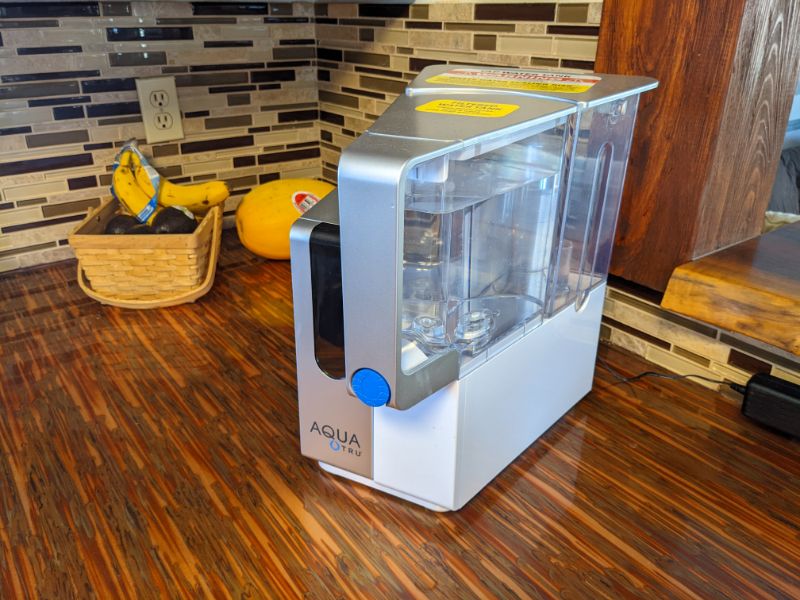
💡 Use UV Light
Chlorine reduction rate: 90-99.99%
Ultraviolet light is most popularly used to kill microorganisms like bacteria and viruses, and many folks don’t know that UV exposure also neutralizes chlorine.
The simplest way to remove chlorine with UV light is to install a UV purification system that treats your water as it flows through your pipes. Most UV systems are installed on your main water pipe, just after the water supply enters your home.
If your budget is tight, a cheap solution is to use our natural UV light source: the sun. Direct sunlight can facilitate up to 90% of chlorine dissipation within two hours.
How it Works
UV light doesn’t kill or physically remove chlorine from tap water. Instead, it causes the chlorine compounds to degrade, so they’re no longer harmful in water.
When water containing chlorine is exposed to UV light, the high-energy photons from the UV light interact with the chlorine molecules. This breaks the bonds that hold the chlorine atoms together and transforms the chlorine into less harmful byproducts.
The Evidence
- One 2009 study evaluated whether UV light could be used as an effective alternative to activated carbon filters for removing chlorine in dialysis water systems. The study concluded that UV could be successfully used to destroy free chlorine and/or chloramines present in water, turning them into easily removed harmless byproducts.
- Another study from 2016 examined the influence of UV fluence dose and transmittance on water dechlorination. In the study, the maximum UV fluence dose applied by scientists was 513 mJ/cm2, which resulted in around 25% of total chlorine reduction.
Best For
Anyone who wants to target chlorine at the same time as protecting their drinking water from microorganisms, or folks who prefer a non-filtering method of reducing the chlorine content in their entire home’s water supply.
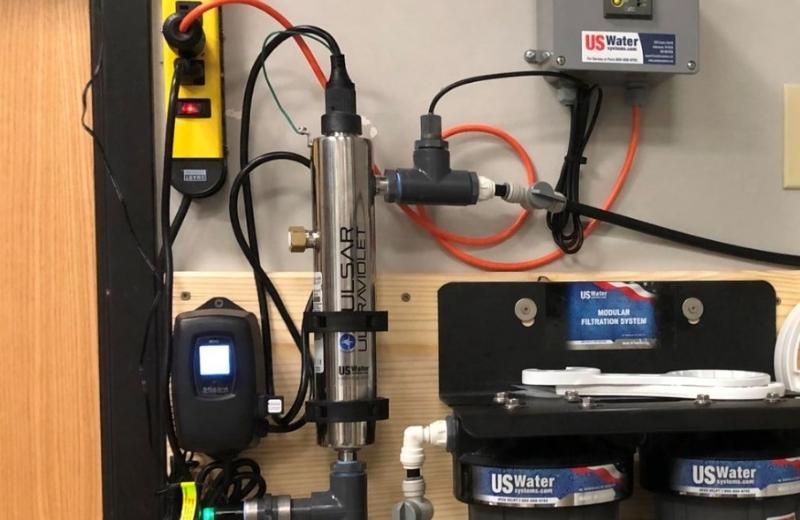
🍋 Add Vitamin C to Water
Chlorine reduction rate: 90-99.99%
Vitamin C, also known as ascorbic acid, neutralizes water. It doesn’t lower dissolved oxygen or affect the pH levels of water, so it’s a safe and effective method to use for dechlorinating drinking water supplies.
The percentage of chlorine neutralized by vitamin C depends on factors including the concentration of chlorine in the water, the form of chlorine present, and the amount of vitamin C used, but it can generally neutralize and remove up to 90-99% of chlorine.
How it Works
Vitamin C the form of ascorbic acid neutralizes chlorine in water using a process called chemical reduction. Ascorbic acid is a strong reducing agent, and reacts with chlorine molecules, transferring electrons to the chlorine atoms. This converts chlorine into chloride ions, rendering it harmless.
Vitamin C is most commonly available in powder form. Follow the instructions on the packaging to sprinkle vitamin C powder into your water (you usually need about one teaspoon for one pint of water).
You can also buy vitamin C tablets, often marketed as “water dechlorination tablets” or “ascorbic acid tablets”, that dissolve in water. Add a tablet to your water for instant dechlorination effects.
Vitamin C balls are commonly added to showerhead water filters to provide a simple chlorine removal solution for your shower water.
The Evidence
- One 2022 report on the use of ascorbic acid for the reduction of chlorine highlighted several studies, including a study that demonstrated that adding one gram (1,000 mg) of ascorbic acid could neutralize 1 ppm of chlorine per 100 gallons of water. However, the report quoted several experts who said that vitamin C isn’t the best solution to remove chlorine from water in a water filter, citing that KDF 55 filtration media is more effective and beneficial.
Best For
Anyone who prefers to add something into their water to remove chlorine rather than filtering it out with a water filter.

📥 KDF-55 Water Filters
Chlorine reduction rate: 95-99.9%
KDF-55 water filters use a high-purity copper-zinc formulation that’s designed to reduce contaminants from water in a process known as redox (reduction-oxidation).
KDF-55 filters are sometimes used instead of activated carbon filters in water filter pitchers, shower filters, and other water filters that are predominantly designed to improve water’s taste and smell.
How it Works
The media in a KDF-55 water filter contains a mixture of copper and zinc granules that generate a small electrical charge when water passes through. This charge facilitates the transformation of some harmful substances – including chlorine – into less harmful forms.
A bonus of KDF-55 is that it also has bacteriostatic properties, meaning it can inhibit the growth of bacteria and algae in water.
The Evidence
- A 2021 review of POU drinking water treatments in the U.S. noted that KDF-55 water filters had shown to be capable of removing over 99.9% even from water with a high initial chlorine concentration of 3 mg/L.
- KDF-55 media is also certified to NSF Standard 42 for removing contaminants with aesthetic effects, including chlorine. That means that any water filter containing KDF-55 media offers certified chlorine reduction.
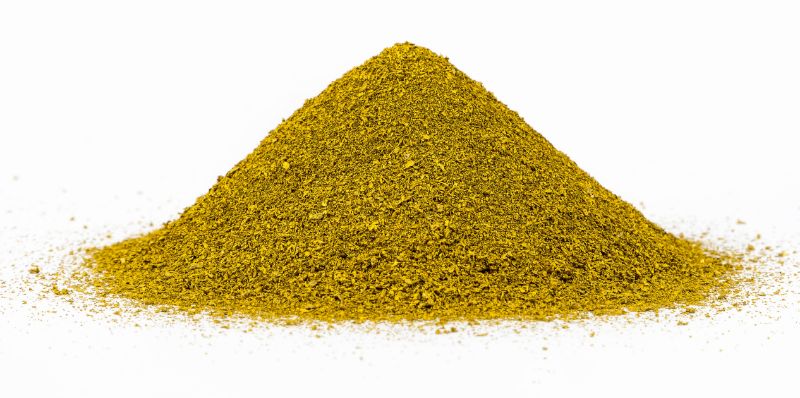
🍶 Water Distillation
Chlorine reduction rate: 95-99.9%
Countertop water filters offer a filter- and chemical-free solution to purifying water and removing hundreds of contaminants, including chlorine.
Like reverse osmosis filters, water distillers are super effective at eliminating the majority of impurities from drinking water. They’re countertop units that just need electricity to operate.
How it Works
A water distiller removes chlorine by heating the water until it evaporates, then condensing it into a separate container.
Chlorine is unable to condense with water at the same temperature, which means it is effectively removed during the distillation process.
Distillation is an incredibly thorough method of purifying water, but it takes a long time – the average point-of-use water distiller takes 4-6 hours to distill just 1 gallon of water.
The Evidence
- A report by an environmental engineering specialist and water quality educator at the University of Nebraska listed chlorine as a contaminant that can be removed by water distillation.
Note: Water distillation isn’t typically recommended by the CDC or EPA as a method of chlorine removal treatment because it isn’t as practical or efficient as other filtration processes.
Best For
Folks who want to dechlorinate tap water with a portable countertop water distillation unit, requiring a longer treatment process but without the hassle and maintenance of filter changes.
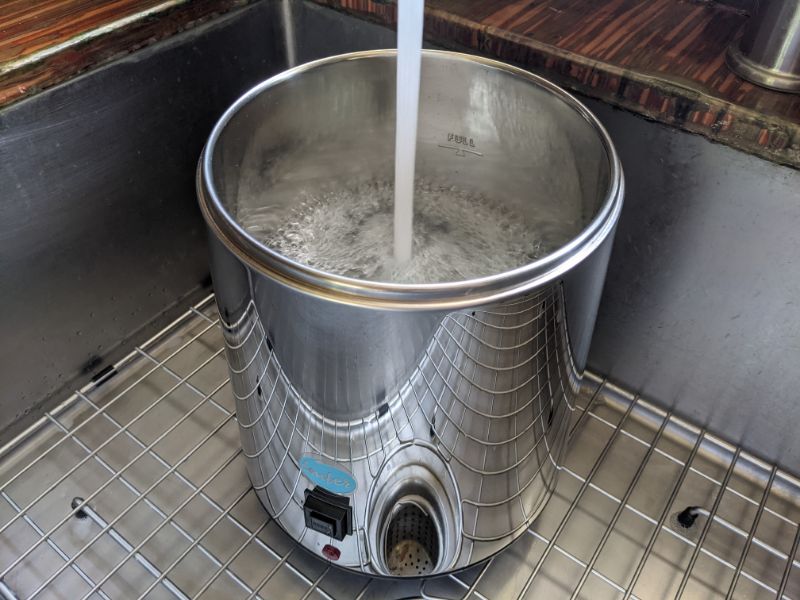
📑 Final Word
If you want to improve the taste of your water and get rid of unpleasant chemical odors, removing chlorine from your drinking water is your best bet. We wrote this article to serve as a go-to resource for folks who want to be aware of all the most effective ways to reduce chlorine from drinking water.
Whether you opt for an efficient, practical chlorine-reducing water filter or an affordable solution that requires minimal equipment, this guide should have given you a comprehensive selection of solutions to choose from.
🧠 How to Dechlorinate Tap Water: FAQs
What’s the most effective way to dechlorinate tap water?
The most effective way to dechlorinate tap water is to use a chlorine removal water filter, such as an activated carbon filter or a reverse osmosis filter. Many filtration methods are capable of removing chlorine to almost 100%. Some filters can remove chlorine and chloramine, while others are designed purely to dechlorinate water.
What’s the cheapest way to remove chlorine from water?
The cheapest way to remove chlorine from water is to let your water sit for 24 hours. While this method might not completely dechlorinate water, most of the chlorine should evaporate into the air. This is the only method of removing chlorine that’s completely free (even boiling water uses energy).
How can I remove chlorine from fish tanks?
The best way to remove chlorine from a fish tank is to add a dechlorination agent. You can buy this from most pet stores. Pour a measured amount of the solution into your fish tank, and it’ll take effect immediately. If your fish tank has a biological filter, you’ll need to choose a dechlorination agent that doesn’t remove ammonia.
How do you remove chlorine from water naturally?
You can remove chlorine from water naturally by boiling water, letting the water sit at room temperature overnight, or using a water filter made from natural media, like an activated carbon filter. All of these methods are cost-effective and chemical-free.
How long does it take to dechlorinate tap water?
Dechlorinating water can be instantaneous or can take several hours, depending on the method used. The fastest way to dechlorinate drinking water is by using dechlorination tablets, which neutralize chlorine in a matter of seconds. Many chlorine-removal water filters also deliver chlorine-free water in less than a minute. Choose a filter that connects up to your main water line to enjoy instantly dechlorinated water.
How long does water need to sit to dechlorinate?
To allow all chlorine to dissipate from a batch of water, you should leave it to sit for five days. 24 hours is the minimum recommended time to reduce your water’s chlorine levels at room temperature.
Can you filter out chlorine from tap water?
Yes, you can filter out chlorine from tap water. Activated carbon and reverse osmosis systems are the best filters for removing chlorine from your tap water supply.

Aloha Brian,
The article doesn’t specify the type of chlorination. Do these dechlorination methods apply only to water treated with chlorine gas or also to more stable forms, such as calcium hypochlorite?
These methods are applicable for any type of chlorine in water
What does it mean to “leave it for 15-20 minutes” in the sentence “Let the water reach a rolling boil, then leave it for 15-20 minutes.”?
Do you mean boil for 15-20? Or just let it sit on the stove with heatsource turned off? Remove from heat and let sit for 15 – 20 mins?
Quite confusing, please clarify.
Let it boil for 15-20 minutes. Thanks for the feedback, I’ll edit the wording!
Keep up the amazing work! Can’t wait to see what you have in store for us next.
Lots of real-world testing projects!
We just wanted to take a moment to acknowledge all the hard work and effort you’ve been putting in lately. Keep up the amazing job, you’re doing great!
Thanks for the kind words and feedback!
KDF-55 water filters that use a high – purity COPPER-ZINC formulation that’s designed to reduce contaminates from under-sink household tap water filters in a process known as REDOX (Reduction Oxidation) over time may be the cause of inoperable progressive gall-bladder cancers that can metastasize to the liver, via copper-zinc formulation metals that are attracted to molecules of fats and oils in foods, that are automatically directed or carried to the gallbladder to be broken down and stored in the human body. KDF-55 water filter use I would not recommend to anyone. This particular filter is replacing chlorine contaminates with highly volatile copper-Zinc heavy metals in the human pathophysiology of the human body.
Thanks for sharing Margaret. I’d be interested to read more on where you sourced this information from. Would you mind sharing a link?